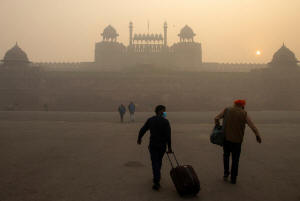|
India, whose cities top global pollution lists, faces a growing
economic as well as human toll from bad air quality, which was
linked to 1.24 million, or 12.5% of total deaths in the previous
such study for 2017.
The analysis found pollution led to chronic obstructive
pulmonary disease, respiratory infections, lung cancer, heart
disease, stroke, diabetes, neonatal disorders and cataracts.
Land-locked New Delhi, the world's most polluted capital whose
winter skies are often obscured by its filthy air,
recorded the highest per-capita economic hit, the journal said.
The fatalities in 2019 led to a total loss of $36.8 billion, or
1.36% of India's gross domestic product (GDP), with the poor and
populous states of Uttar Pradesh and Bihar experiencing the
highest economic loss as a percentage of their GDP.
Although the death rate due to household air pollution fell
64.2% from 1990 to 2019, that due to ambient particulate matter
pollution more than doubled, The Lancet said.
"The improvements in air quality across India during the
COVID-19 lockdown period, and its upsurge again with the easing
of restrictions, provide interesting pointers to the extent of
air pollution reduction that is possible with reduced human
activity," it added.
The government said in a statement that India would need to
invest more in state-specific pollution control programmes if it
were to meet its goal of becoming a $5 trillion economy by 2024,
from around $2.9 trillion now.
India's three main cities, New Delhi, Kolkata and Mumbai, were
on the list of the world's 20 worst polluted cities, Swiss air
quality technology company IQAir reported on Tuesday.
(Reporting by Sachin Ravikumar and Krishna N. Das; Editing by
Alexander Smith)
[© 2020 Thomson Reuters. All rights
reserved.] Copyright 2020 Reuters. All rights reserved. This material may not be published,
broadcast, rewritten or redistributed.
Thompson Reuters is solely responsible for this content.

|
|






